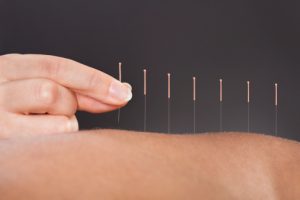
The use of steroid injections is not recommended in the long term, however, as they can contribute to many unwanted side effects. But according to researchers at Baylor Scott & White Health in Temple, Texas, dry needling—which uses filament needles to simulate sensitive loci or trigger points in the muscle—was found to be as effective as cortisone injections for reducing pain and improving movement problems, like those seen in greater trochanteric pain syndrome (GTPS).
GTPS is estimated to affect about 10 to 25 percent of the general population and is characterized by a swollen hip bursa—a fluid-filled sac that acts as a gliding surface to reduce the friction between moving tissues in the hip joint. It is more common in women and in patients with coexisting lower back pain, osteoarthritis, iliotibial band tenderness, and obesity. The hip pain can be so excruciating that you may seek out steroid injections to the bursa to help decrease swelling and pain. However, new evidence suggests that inflammation is not the source of the pain, rather, the injuries to the muscles and tendons around the hip are actually the culprit. This discovery has brought into question the use of steroid injections and the possibility of using other treatments such as dry needling.
“The potential detrimental side effects of steroid injection, particularly repeated injections, are of concern for patients and providers alike.” As a result, “the identification of a comparable treatment alternative with minimal side effects, such as dry needling, offers valuable clinical advantages,” said lead author Kindyle L. Brennan, Ph.D.
Dry needling is a physiotherapy technique that is performed with acupuncture needles. It assists those with pain and can aid in rehabilitation. Solid filament (acupuncture needles) are introduced to the skin and tissues below, with the term “dry needling” being using to differentiate it from “injection.”
The research study treated 43 patients with GPTS and a total of 50 painful hips. Patients were randomly assigned to one of two groups: one receiving cortisone, and the other receiving dry needling. Six weeks of treatments were administered to each group, with clinical outcomes collected at the start of the trial, and at one, three, and six weeks. Pain and function of the joint were also measured in addition to other clinically relevant information.
The results of the study showed that cortisone injections did not provide a better outcome than dry needling for either pain or function in these patients. Both groups did receive decreased pain and improved hip movement.
Early evidence backing dry needling as a treatment for GTSP and disorders like it look promising. It has the potential to eliminate the use of medications that have unwanted long-term side effects. However, Dr. Brennan acknowledges that the evidence is still in its infancy and that further studies are necessary.
Related: Acupuncture increases effect of medical care for chronic pain, depression